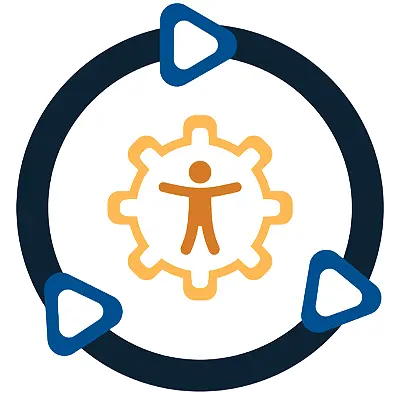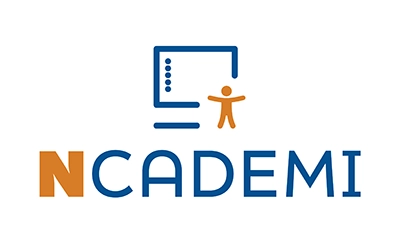
Statement
State and local educational agencies (SEA and LEAs) plan for sustaining the activities and resources that support a coordinated system for providing accessible digital educational materials.
Intent
Sustainability is the process of turning an initiative into a lasting, established program—and keeping it going over time. Using assessment data in cycles and adopting a continuous improvement mindset are critical to sustainability. An agency uses transparent communication and dissemination strategies to sustain its ongoing efforts and success. Resources are allocated and responsively adjusted to sustain continuous improvement.
Critical Components
To effectively address Quality Indicator DM7, the following components should be present:
DM7.1 Routine Self-assessments
Conduct routine self-assessments to identify areas for growth and measure continuous progress toward meeting the Quality Indicators with Critical Components for the Provision and Use of Accessible Digital Educational Materials.
DM7.1 Self-Assessment Scoring Matrix
| Not Started | Emerging | Operationalizing | Scaling & Sustainability |
|---|---|---|---|
| The need to conduct self-assessments to measure continuous progress toward meeting the Quality Indicators with Critical Components for the Provision and Use of Accessible Digital Educational Materials has not yet been considered. | The SEA and LEAs (“the agency”) are reviewing NCADEMI’s self-assessment tool and planning how to incorporate it into system improvement efforts. Leaders are identifying who will participate, what data will inform the assessment, and how results will be used. Early discussions may include aligning the self-assessment process with broader strategic planning. | The agency has launched a baseline self-assessment of at least three Quality Indicators with Critical Components, with a plan to progress through all seven. Key staff with critical perspectives are involved in the self-assessment process. Results inform specific program areas, such as PD or procurement improvements, and some actions have been taken. Procedures for consistently tracking progress over time are being developed. | The agency has instituted routine cycles of self-assessment of all seven Quality Indicators. Assessment results guide planning, resource allocation, and engagement with leadership, staff, and community members. Results are used to celebrate progress and address persistent gaps. |
The scoring matrix is part of the Quality Indicator Self-Assessment Tools.
DM7.2 Internal Communication Strategy
An internal communication strategy to keep staff informed of:
- The status of the agency’s progress toward implementing guidelines for providing accessible digital educational materials
- Related training and professional development (PD) opportunities
- Ways to request technical assistance and support
- Opportunities to provide feedback on what’s working and what needs to be improved
DM7.2 Self-Assessment Scoring Matrix
| Not Started | Emerging | Operationalizing | Scaling & Sustainability |
|---|---|---|---|
| The need for an internal communication strategy has not yet been considered. | The SEA and LEAs (“the agency”) are identifying key internal audiences (e.g., instructional staff, IT, procurement, leadership) and planning how to keep them informed. Messaging goals, communication channels (e.g., newsletters, staff portals), and roles for maintaining communication are being defined. Planning includes ways to gather staff feedback. | Internal communication about digital accessibility is underway within the agency. Relevant leadership and staff begin to receive information about the agency’s guidelines, available training and PD, and how to request support. There are emerging channels for staff to share questions or concerns, and feedback about communication is beginning to be used to improve messaging and outreach. | A comprehensive internal communication strategy keeps all staff regularly informed about the agency’s progress, expectations, training and PD, support options, and ways to provide feedback. Communication is timely, accessible, and coordinated across divisions. The agency routinely uses staff feedback to improve internal communication methods. |
DM7.3 External Communication Strategy
An external communication strategy to keep families and community members informed of:
- The status of the agency’s progress toward digital accessibility improvements
- Ways to provide feedback on their children’s experience with the educational materials provided by the agency
- Services and resources for supporting their children who require accessible digital educational materials
- For parents and caregivers with disabilities, a way to provide feedback on their own experience with supporting their children’s education
DM7.3 Self-Assessment Scoring Matrix
| Not Started | Emerging | Operationalizing | Scaling & Sustainability |
|---|---|---|---|
| The need for an external communication strategy has not yet been considered. | The SEA and LEAs (“the agency”) are identifying the best ways to reach families and community members with updates and support related to digital accessibility. Communication goals, accessible formats, translation needs, and contact points for feedback are being developed. Planning includes specific outreach for families of students with disabilities and parents/caregivers with disabilities. | The agency is actively communicating with families and community members about accessibility-related actions, supports, and feedback opportunities. Information is shared through accessible channels (e.g., website, newsletters, family engagement nights). Initial steps are in place to ensure parents with disabilities can share their own experiences. The agency is refining external communications based on feedback. | The agency maintains a coordinated, accessible external communication strategy that consistently shares updates, resources, and multiple ways for families and community members to provide feedback. Communication reaches diverse family populations, including those with disabilities. The agency regularly reviews the communication strategy and uses feedback from families and the community to continuously improve its outreach efforts. |
DM7.4 Dissemination Strategy
A dissemination strategy to ensure guidelines are widely available through varied means to reach all applicable parties.
DM7.4 Self-Assessment Scoring Matrix
| Not Started | Emerging | Operationalizing | Scaling & Sustainability |
|---|---|---|---|
| The need for a dissemination strategy to ensure guidelines are widely available has not yet been considered. | The SEA and LEAs (“the agency”) are identifying the various audiences who need access to digital accessibility guidelines (e.g., educators, IT staff, vendors, community partners) and planning how to distribute them in accessible, practical formats. Dissemination goals, responsibilities, and preferred communication channels are being established. | The agency is sharing digital accessibility guidelines through multiple channels, such as the agency website, internal training hubs, vendor onboarding documents, and printed materials. Efforts are underway to ensure the content is accessible, easy to navigate, and tailored by audience. Dissemination is coordinated across departments. | The agency has a sustained dissemination strategy that ensures accessibility guidelines are easily available and routinely updated across platforms and formats. All relevant audiences know where to find the guidelines and how to apply them. The strategy ensures equitable access—including in-person, digital, and accessible formats—and is regularly evaluated for reach and effectiveness. |
DM7.5 Resource Allocation
Allocation of resources to sustain coordinated fiscal, human, and infrastructure needs, including consideration of:
- Alignment of staff roles and responsibilities with the agency’s digital accessibility obligations
- Funding models
- Grant opportunities
- Budgeting strategies
DM7.5 Self-Assessment Scoring Matrix
| Not Started | Emerging | Operationalizing | Scaling & Sustainability |
|---|---|---|---|
| The need to allocate resources to sustainably meet fiscal, human, and infrastructure needs has not yet been considered. | The SEA and LEAs (“the agency”) is reviewing existing resource allocations (staffing, technology, funding) and identifying gaps in capacity to meet digital accessibility obligations. Planning is underway to align staff responsibilities, explore funding models or grant opportunities, and build accessibility into budget requests and program plans. | The agency has begun to allocate specific resources—such as dedicated staff time, accessible infrastructure upgrades, or budget lines—for implementing accessibility practices. Accessibility responsibilities are being formalized in position descriptions, and the agency is seeking or leveraging funding opportunities to expand or sustain efforts. | The agency has a long-term, coordinated approach to resource allocation that supports all aspects of its digital accessibility system. Accessibility is reflected in staffing, job responsibilities, budgets, procurement plans, and infrastructure investments. The agency actively pursues and integrates grant funding to sustain accessibility. Cycles of self-assessment inform resource planning. |
